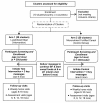Complementary feeding: a Global Network cluster randomized controlled trial
- PMID: 21232139
- PMCID: PMC3032692
- DOI: 10.1186/1471-2431-11-4
Complementary feeding: a Global Network cluster randomized controlled trial
Abstract
Background: Inadequate and inappropriate complementary feeding are major factors contributing to excess morbidity and mortality in young children in low resource settings. Animal source foods in particular are cited as essential to achieve micronutrient requirements. The efficacy of the recommendation for regular meat consumption, however, has not been systematically evaluated.
Methods/design: A cluster randomized efficacy trial was designed to test the hypothesis that 12 months of daily intake of beef added as a complementary food would result in greater linear growth velocity than a micronutrient fortified equi-caloric rice-soy cereal supplement. The study is being conducted in 4 sites of the Global Network for Women's and Children's Health Research located in Guatemala, Pakistan, Democratic Republic of the Congo (DRC) and Zambia in communities with toddler stunting rates of at least 20%. Five clusters per country were randomized to each of the food arms, with 30 infants in each cluster. The daily meat or cereal supplement was delivered to the home by community coordinators, starting when the infants were 6 months of age and continuing through 18 months. All participating mothers received nutrition education messages to enhance complementary feeding practices delivered by study coordinators and through posters at the local health center. Outcome measures, obtained at 6, 9, 12, and 18 months by a separate assessment team, included anthropometry; dietary variety and diversity scores; biomarkers of iron, zinc and Vitamin B12 status (18 months); neurocognitive development (12 and 18 months); and incidence of infectious morbidity throughout the trial. The trial was supervised by a trial steering committee, and an independent data monitoring committee provided oversight for the safety and conduct of the trial.
Discussion: Findings from this trial will test the efficacy of daily intake of meat commencing at age 6 months and, if beneficial, will provide a strong rationale for global efforts to enhance local supplies of meat as a complementary food for young children.
Trial registration: NCT01084109.
References
-
- Jones G, Steketee RW, Black RE, Bhutta ZA, Morris SS. How many child deaths can we prevent this year? Lancet. 2003;362(9377):65–71. - PubMed
-
- Caulfield LE, Huffman SL, Piwoz EG. Interventions to improve intake of complementary foods by infants 6 to 12 months of age in developing countries: Impact on growth and on the prevalence of malnutrition and potential contribution to child survival. Food Nutr Bull. 1999;20(2)
-
- Victora CG, de Onis M, Hallal PC, Blossner M, Shrimpton R. Worldwide timing of growth faltering: revisiting implications for interventions. Pediatrics. 2010;125(3):e473–480. - PubMed
-
- World Bank. Repositioning nutrition as central to development: A strategy for large scale action. Washington, DC: The World Bank; 2005.
Publication types
MeSH terms
Associated data
Grants and funding
LinkOut - more resources
Full Text Sources
Medical


